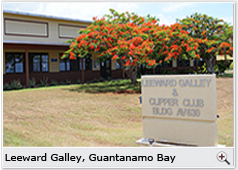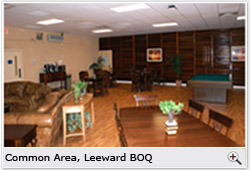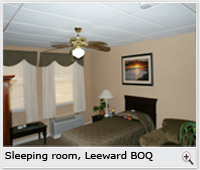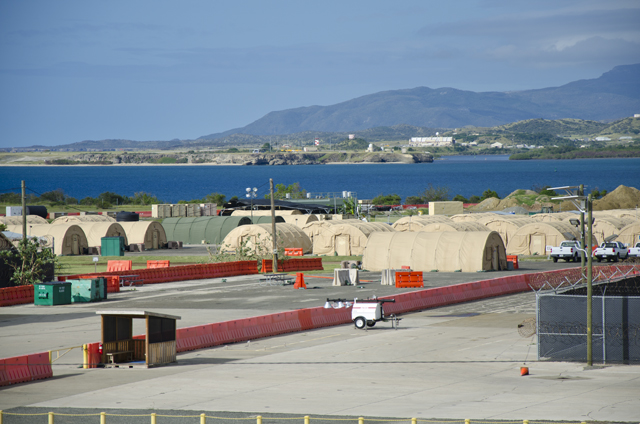
U.S. Naval Station Guantanamo Bay, Cuba, located on the southeast coast of Cuba, has served as the location for conducting military commissions since 2004. In operation since 1903, the Naval Station provides essential logistics support to U.S. and coalition maritime forces in the Caribbean Sea. It also houses law of war detainees at the detention facility run by Joint Task Force Guantanamo (JTF-GTMO). Military commissions operate in facilities on a former military air field in an area designated “Camp Justice.”
Office Space
Expeditionary Legal Complex (ELC)
Constructed from August 2007 through January 2008 to provide a location where classified trials could be conducted at the level of Top Secret or above, the ELC includes office space and equipment, Courtroom II, and associated technology/equipment. The ELC was constructed by a U.S. Air Force civil engineering unit, with excavation beginning on Sept. 11, 2007.
In the ELC, the Prosecution has a trailer with four large offices and one open area. The Defense has a trailer with eight large offices. The Convening Authority has a trailer which includes one judge office, three offices for court reporters and staff, and one open area. All offices have closed-circuit television feeds from Courtroom II.
AV-34 (Aviation Building 34)
AV-34 contains Courtroom I and also contains office space. Prosecution and Defense both have two small and two large offices. All offices have closed-circuit television feeds from Courtrooms I and II.
AV-29 (Aviation Building 29)
AV-29 provides Prosecution with three small offices and one large open office area, Defense with 12 offices plus a large conference room with video teleconferencing (VTC) capabilities and the Convening Authority with six offices and a conference room with VTC capabilities. All offices have closed-circuit television feeds from Courtrooms I and II.
National Capital Region (NCR)

Most OMC personnel live and work in the National Capital Region and travel to Guantanamo Bay, Cuba, as required. OMC provides office space and resources in the NCR for the following OMC personnel and participants: Office of the Convening Authority, Office of the Chief Prosecutor, Office of the Chief Defense Counsel, Office of the Military Commissions Trial Judiciary, and the U.S. Court of Military Commission Review.
Courtrooms
The Office of Military Commissions (OMC) Courtroom has state-of-the-art technology, which allows evidence to be presented and retained electronically while preserving public access to military commission proceedings and protecting national security.
Both Office of Military Commissions (OMC) Courtrooms I and II have state-of-the-art technology, which allows evidence to be presented and retained electronically while preserving public access to military commission proceedings and protecting national security.
Equipment in the OMC courtrooms is similar to, but more advanced than, that in most U.S. federal courtrooms. The equipment was installed to ensure that the level of litigation support met or exceeded both U.S. and international standards.
Most military commission proceedings require real-time interpretation of the proceedings into a language the accused understands. Interpreters are not physically present in the courtroom, but are in another location where they interpret using real-time audio and video feeds. This allows DoD to protect the identity of the interpreters, and also allows for interpretation into multiple languages, if required. Non-English speakers can hear the interpretation using wireless, infrared headphones. The defense team may also have an interpreter assigned to assist communications between counsel and the accused. That interpreter sits in the courtroom.
Any commission proceedings which are open to the public are transmitted by closed-circuit television to the nearby Media Center. This allows members of the media to either sit in the courtroom, or watch the proceedings in the Media Center where they can simultaneously work on their stories.
Each courtroom has video teleconferencing (VTC) capability so that witnesses in other locations can testify via VTC if they are unable to travel to Guantanamo Bay.
Consistent with U.S. practice in federal courts and courts-martial, no photographs or videos of trial proceedings are retained. The only official record of trial proceedings which is retained is that taken by the court reporter.
In each courtroom, counsel may display evidence electronically using a laptop at either the podium or the counsel table, or using a document camera, VHS tape player or DVD player. Each panel member (a.k.a. “juror”), the military judge and the audience have video screens on which to view the evidence as it is being presented. Any evidence presented in this manner also appears on the closed-circuit televisions in the Media Center. Courtroom I is located in AV-34 (Aviation Building 34), and is a single-defendant courtroom capable of trying a capital case. This courtroom can be used for trials where information is at the classification level of Secret or below. Located in the Expeditionary Legal Complex (ELC), Courtroom II is a multi-defendant courtroom capable of trying up to six defendants jointly. This courtroom can accommodate a capital case, and has unique features that permit the use of highly-classified information at the Top Secret/Sensitive Compartmented Information (TS/SCI) level or below during proceedings.
Unique Features in Courtroom II
Spectator Gallery
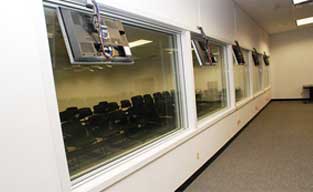
The spectator gallery in Courtroom II was specially designed to permit public viewing of the proceedings even where classified information may be used. The gallery accommodates 34 spectators in raised seating to provide a view of the courtroom. It has video screens that play a closed-circuit television feed of the proceedings and a sound system that plays the audio feed. To prevent inadvertent disclosure of protected information, the gallery is separated from the trial area by soundproof glass, the audio feed to the spectators is delayed for 40 seconds and both the audio and video feed may be cut off if necessary. If victims or family members are present in the gallery, they enter last and are seated nearest to the exit. A curtain is available to separate the victims and family members from other spectators if they desire privacy.
Holding Cells
As defendants are transported to and from the courtroom each day, they sometimes spend a considerable amount of time outside the courtroom during recesses or while awaiting transport. Consequently, the ELC contains holding cells that include bunks for sleeping, desks and sanitary facilities.
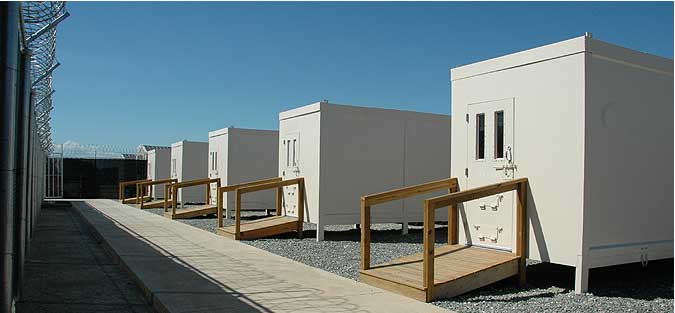
The holding cells have a vestibule area where detainees can meet with counsel. The vestibule has electrical outlets so that counsel can plug in their computers or other equipment. The vestibule area can also be used to set up a telephone (secure or unsecure) so that counsel can make calls from the cell.
In the event that a detainee decides not to enter the courtroom or is removed for disruptive behavior, a television with a closed-circuit audio and video feed from the courtroom is provided in the cell. If the detainee requires the services of an interpreter, the defense team interpreter can sit in the vestibule area and provide those services.
If a hearing overlaps with designated Muslim prayer times, court is usually recessed and detainees are provided prayer time in the holding cells along with any required religious items.
These cells were specially designed for this mission in coordination with the U.S. Marshals Service; they meet Marshals Service and U.S. Federal Bureau of Prisons standards.
Dining
Visitors to U.S. Naval Station Guantanamo Bay may dine at the Naval Station dining facilities. These include Naval Station galleys, fast food outlets, restaurants, snack bars and a coffee shop.
People attending or participating in military commissions dine at the Naval Station dining facilities. These include Naval Station galleys, fast food outlets, restaurants, snack bars and a coffee shop. The Naval Station’s Commissary (grocery store) and Exchange (general merchandise) are also available for military commissions participants and attendees.The Naval Station website contains more detailed information.
Lodging
Lodging at Guantanamo Bay, Cuba, is provided in accordance with the OMC Housing Policy.
Camp Justice
Most military commissions personnel are lodged at Camp Justice, which has 50 beds in air-conditioned trailers (aka Cuzcos). Each trailer has a refrigerator, microwave, coffee maker, television, DVD player and a shared bathroom/shower. If additional housing is required, there are more than 60 beds available in air-conditioned tents. Each tent contains six twin beds, plywood floors and partitions, a refrigerator, a microwave and electrical outlets. If required, Camp Justice can be configured to house more than 300 individuals. Lodging for personnel traveling to Guantanamo Bay in support of military commissions will be arranged in accordance with the OMC Housing Policy
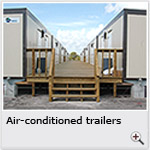
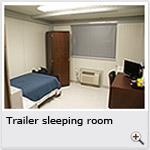
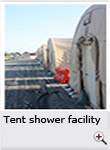
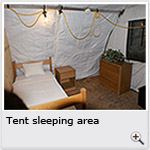
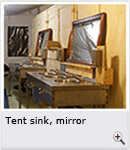
Naval Station
Judges, witnesses, panel members (jurors) and victims/family members are billeted in housing provided by U.S. Naval Station Guantanamo Bay. There is a variety of housing areas, but all provide rooms which are similar to hotels in the United States.
